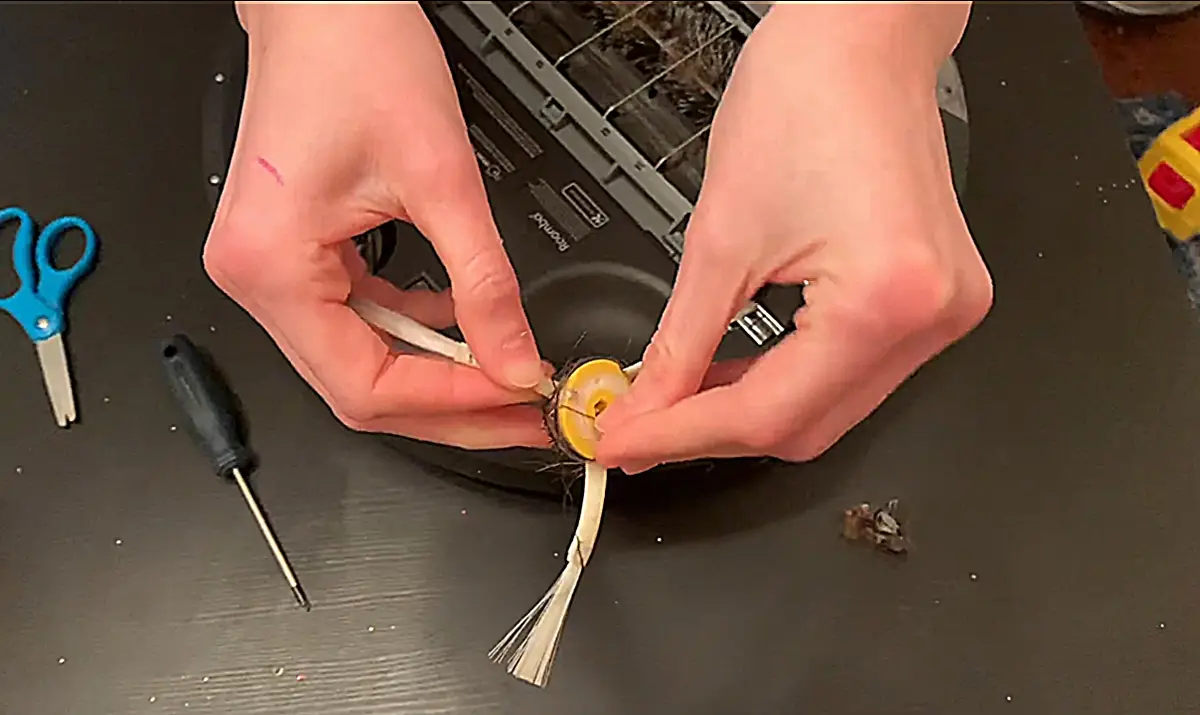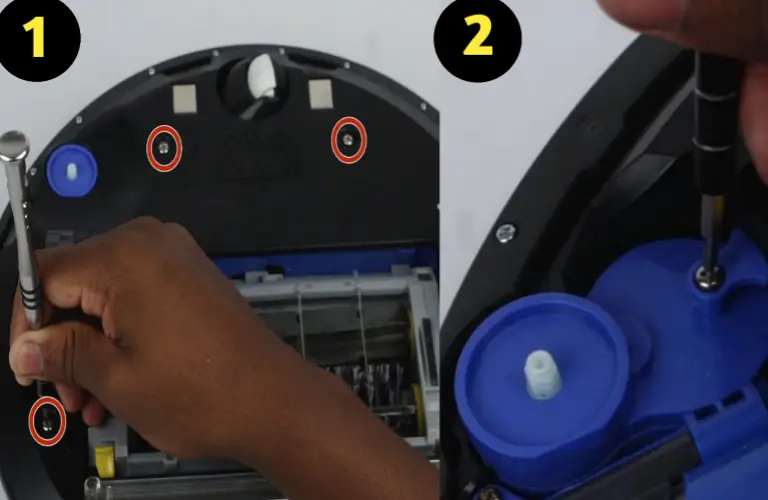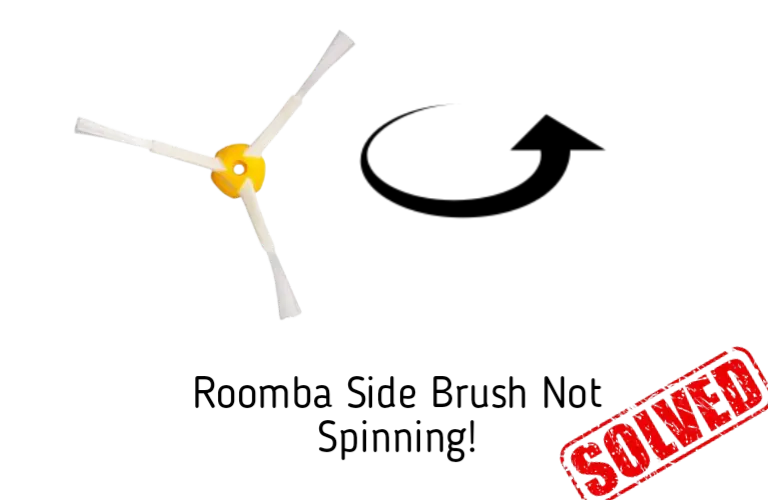You’ve been working hard on maintaining your household, and your Roomba has been working just as hard to ensure it’s clean.
That is until the day you notice that your Roomba isn’t picking up the dirt anymore – instead, it seems to be sitting in one place, moving around in an aimless circle.
You check its dustbin and see that it still has plenty of space left to hold more dirt, so you know it must be something else causing this problem…and later, you discover that the side brush isn’t spinning.
Well, let’s proceed to the guide!
What is actually preventing the brush from spinning?
There could be several reasons why the brush on your Roomba isn’t spinning.
Here are a few possible causes.
♦ Brush obstruction
Over time, hair, thread, pet fur, and other debris can get tangled around the brush bristles.
When the brush is obstructed, it becomes difficult or impossible for it to rotate freely. This happens particularly if you have not cleaned the brush for a while or recently vacuumed an area with a lot of loose debris.
♦ Brush motor issue
Motor is responsible for spinning the brush.
If the motor is faulty, it may not receive the necessary power to operate or may have internal components that are not functioning correctly. This can result in the brush not spinning at all or spinning intermittently.
♦ Belt or brush module issue:
Some Roomba models use a belt to transfer power from the motor to the brush.
Over time, the belt becomes worn out, stretched, or even broken. In other cases, Roombas have a separate brush module that houses the brush and its motor. If this module is misaligned or damaged, it can prevent the brush from spinning properly.
♦ Software issue
Occasionally, software glitches or errors within the Roomba’s programming affect its performance.
If there is a bug or issue with the software controlling the brush motor, it may not receive the proper commands to spin or may not receive them consistently. But remember, it’s a very rare case.
How to Fix This Issue?
- Inspect the brush for any obstructions.
- If the brush is tangled with hair or debris, clear them.
- If the brush still doesn’t spin, clean the gearbox module.
- Apply a small amount of WD-40 to the gearbox module.
Here are the detailed guidelines:
Step 1: Untangle the side brush
No need to mention again: During cleaning, a significant amount of hair and debris accumulate and get caught up in the side brush.
If not cleaned regularly, this buildup hinders the brush from rotating properly.
Additionally, you may notice that your Roomba is generating excessive noise or emitting a high-pitched squeaking sound.
However, here’s how:
- Remove the Screw: Use a Phillips head screwdriver to remove the screw that holds the side brush in place.

- Clean the side brush: Carefully remove the side brush and use a pair of scissors to cut away any tangles.

- Reinstall side brush: Once done clearing the tangles and dirt, replace the side brush and screw it back into place.
When you’re done, press the “clean” button on your Roomba.
The brush should now spin without any issues.
WARNING: Handle the bristles with care to avoid damage. If the brush is excessively hairy, use a razor blade to cut. Remember to replace the side brush and properly secure it in place after shaving.
Step 2: Clean the side brush module/gearbox
This is a small piece of hardware attached to a motor that powers the brush. It contains metal or plastic gear shafts that become dusty over time and get jammed.
Open the gearbox module and clean the dirt inside it.
You might find that some gear shafts are broken or misplaced, which you need to replace.
Here’s how to do this:
- Unscrew the screws: remove the screws on Roomba’s back cover that hold the gearbox cover in place.

- Clean the dirt: Look for hair or other debris inside the gear case. If you find any, clear it.

- Put the Gearbox in its place: Once done, screw it back in place.
Now, test if it’s spinning freely. If the brush still doesn’t rotate, you may need to replace the entire Gearbox. Before that, move on to the next step.
WARNING: Carefully remove the cover, being cautious not to lose any small parts inside
Step 3. Lubricate the Gearbox

After cleaning the gearbox, apply some dry lubricant like WD40 to make the gear shafts more efficient and working.
This is because when the gear shafts get old, they can stick more and more due to rusting. Applying some lubricant will ensure that it can spin correctly.
When you finish lubricating the gearbox module, reassemble the Roomba correctly. Ensure that all components are securely in place. After some time, restart your Roomba and check if the side brush is now spinning correctly.
Tips: Contact iRobot and describe the side brush’s behaviour. They will send you replacement parts if you have a warranty.
Step 4: Replace the side brush module/GearBox

If none of the above troubleshooting steps fixes the problem, replace the Gearbox with a new one. Fortunately, replacing the gearbox/side brush module isn’t complicated. Follow the below steps:
- First, remove the screw from the side brush module.
- Pull the side brush module out of the Roomba.
- Insert the new side brush module into the Roomba.
- Replace the screw in the side brush module.
If it still doesn’t work, the motherboard may have a problem. In this case, contact iRobot customer service and describe your issue. They may help you fix the problem.
F.A.Q.s
Q. How do I test my Roomba brush motor?
Testing the motor of your Roomba’s side brush is relatively easy. Follow the below steps:
- Remove the brush motor from your Roomba.
- Using a multimeter, test the continuity of the brush motor’s winding.
- If the winding is open, the brush motor needs to be replaced.
- If the winding is continuous, the brush motor is fine; you just need to clean the brushes.
You can also test the side brush motor by using a 9V battery.
You need to wire the battery terminals to the + and – terminals on the motor and see if it spins. If it works, then it’s likely the problem is the motherboard’s output.
If not, make sure your connections to the motor and the battery are good.
Q. How long does a Roomba side brush last?
The side brush can last anywhere from six months to a year, depending on how often you use your vacuum. If you have a pet or live in a dusty area, you may need to replace the brush every 2-3 months.
Q. Will my Roomba work without a side brush?
The short answer is “NO.”
Side brushes are responsible for sweeping debris into the path of the main brush, which then sucks it up into the vacuum chamber.
For this reason, running the Roomba without brushes will do nothing.
Q. Is it possible to replace the side brush on my Roomba?
Yes, it is possible to replace the side brush on your Roomba.
Most Roomba models have easily replaceable side brush modules. You can purchase a compatible replacement part from the manufacturer or authorized resellers.
Refer to your Roomba’s user manual or the manufacturer’s website for instructions on how to properly replace the side brush.

Vacuum master from Gazipur, Bangladesh! He knows vacuums inside and out and has been fixing them for ages. When he’s not busy repairing vacuums, Mizanur writes these super helpful guides for Homespoiler.com. His guides are packed with all sorts of tips and tricks to help people fix their vacuums and keep them running smoothly. More about him.

